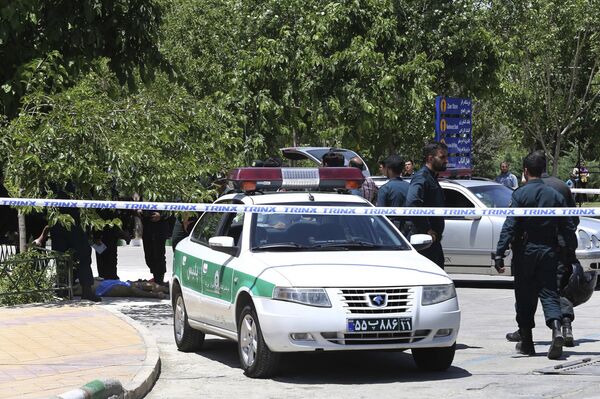On Wednesday (June 7) four terrorists dressed in women's clothing and armed with Kalashnikov rifles killed 12 people and injured 39 in an attack on the Iranian Parliament.
A suicide bomber detonated a device at the mausoleum dedicated to Ayatollah Khomeini, who overthrew the Shah in 1979 and founded the Islamic Republic of Iran. He died in 1989. A third attack was foiled by the Iranian security forces.

The attacks were the first time the Islamic Republic has been targeted by terrorists in the modern era.
Another attack involving an explosion took place near the Imam Khomeini shrine. Two people were reportedly arrested near the shrine.
According to the Press TV channel, security forces discovered eight hand grenades, 10 magazines with ammunition and a bottle of unknown pink liquid in possession of an attacker who was shot dead at the Imam Khomeini shrine.
VIDEO: Gunfire heard at the Iranian Parliament Building. — @Zahra__Rahimipic.twitter.com/299c42BTgc
— Conflict News (@Conflicts) June 7, 2017
The incident comes only days after diplomatic relations with Qatar were broken off by Saudi Arabia and a number of other countries who claimed Qatar was supporting terrorism.
But the dispute is thought to be part of a proxy war between Saudi Arabia and Iran, which is said to be close to Qatar.
"The Iranian government is in a very complex predicament at the moment. It has been thrust into the middle of the crisis between Qatar and the bloc led by Saudi Arabia and it has been trying to shore up its relations with Qatar in the process. We know that some people within Iran will try to point the finger at Saudi Arabia and say they bear some responsibility for these attacks," Dr. Siavush Randjbar-Daemi, Lecturer in Iranian History at University of Manchester, told Sputnik.
It's clear that the strategy of Daesh, if you assume that Daesh was behind this, was to strike at the symbols of power in the Islamic Republic.
"The Islamic Republic is involved in the Middle East, and has been fighting against ISIS [Daesh] in both Iraq and Syria, but it’s also inhabited by Shias, who are of course seen as apostates and as deviants from the rightful Muslim path by many Sunni Muslims," he told Sputnik.
Note to Potus: condemnation of terrorism cannot be selective if it is to have meaning. must condemn it in Tehran as well as in Europe
— Richard N. Haass (@RichardHaass) June 7, 2017
Dr. Randjbar-Daemi added that whenever Shias fell into the hands of Daesh or other extremist Sunni fundamentalists they were "instantly sentenced to death" simply for their religious beliefs.
"This is ISIS trying to extract maximum political and, in some ways, religious capital at a moment when it's under a severe, severe threat. Raqqa is being laid siege to and control of Mosul is progressively vanishing as well.
"It's an attack that ISIS has produced to really try to show off its support within the Sunni world.
"ISIS clearly has a long list of grievances against Iran, which has been active in support of [Syrian President] Bashar al-Assad since day one together with Russia, and it has had a lot of military people killed in Syria fighting ISIS." Dr Randjbar-Daemi told Sputnik.
In December 2014, Iranian Revolutionary Guards Brigadier-General Hamid Taqavi was killed by a sniper while training Iraqi soldiers fighting Daesh.
"In 2014, after the capture of Mosul, the only thing stopping ISIS marching all the way to Baghdad was a quick offensive reaction put together by Qasem Soleimani, the head of the Quds Force of the IRGT (Iranian Revolutionary Guards)," Dr Randjbar-Daemi said.
.@UN extends condolences to families of victims of #Tehran attacks.
— Gary Lewis (@GaryLewisUN) June 7, 2017
Hate drives terror.
But love and search for peace will win in the end. pic.twitter.com/OjpvWub7z6
He said there would inevitably be an inquest within President Rouhani's government about how this attack was allowed to happen, especially considering the strict gun control laws in Iran.
"I can't recall any such attack in the last 35 or 40 years in Tehran. There has been no such armed attack on the Iranian Parliament or such glowing symbols of the Islamic Republic," Dr. Randjbar-Daemi told Sputnik.
He said it appeared that security at the Parliament building was "relatively lax."


